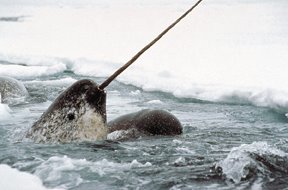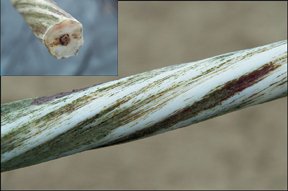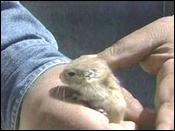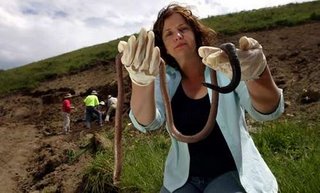A scientific report shows that clean up crews and others working with the molded debris from Huricanes Rita and Katrina can breathe in spores from a black mold (stachybotrys chartarum). The microbe produces a toxin (satratoxin) that kills brain cells! It also produces, as a side effect, asthma. In animal tests, within one day, up to 80% killed the nerve cells that detect smells.
Beware.
[Science News, March 25, 2006.]
Thursday, March 30, 2006
Ramphastos toco: Toucan

A scanning electron micrograph (inset) of the layered and staggered keratin (hard tissue like fingernails) tiles that make up the outer shell of a Toco toucan's beak.
The Toco toucan (Ramphastos toco) has a thick, roughly 20-cm-long (almost 8") beak that makes up a third of the bird's length. The Toco, which lives in the jungle canopies of South America, dines on tree fruits growing at the ends of branches. The birds perches on sturdier portions of a branch and relies on its beak's length to reach a meal. Once the toucan secures a piece of fruit in the tip of its beak, the bird tosses the food into the air and catches it closer to its throat.
Euplectella Aspergillium

The sea sponge has a unique architecture more sphisticated than current mechanical human technology. A skeleton made of silica and chalk, it is very strong. Like the Toucan beak, it uses a special geometry and is basically made of glass, but lives at crushing depths. A heavy man can jump up and down on it with little effect.
The crisscross beams in the walls of the silica sea sponge Euplectella aspergillum make up one of several strength-bestowing levels of design.
Narwhals


Martin Nweeia noticed the sound. In May 2000, spring was just reaching Baffin Island in the Canadian Arctic and he looked out on the those tusk-bearing, high-Arctic whales. "I was sitting on a bucket out on the ice doing polar bear watch," he says. "Then, I heard the breathing."
10 narwhals that had risen to the surface out in the open water. Their heavy, low-frequency, methodical breaths carried through the night as if "they were breathing in my ear,"
Many people have searched for narwhals, but Nweeia may be the only Connecticut dentist to have done so. He practices at Harvard School of Dental Medicine in Boston. And what's there for a dentist not to love about an animal with a 3-meter-long tooth—and the only spiraling tooth ever reported? The left tooth of a male narwhal develops into a tusk several meters long. It's the only tooth known to spiral. The narwhal tooth is what collectors in bygone centuries got when they bought a unicorn horn.
Tuesday, March 28, 2006
Monday, March 27, 2006
Beasts are disappearing :(

Global Warming and terraforming is killing many of our weird beasts. Last year, researchers in Costa Rica announced that two-thirds of 110 species of colorful harlequin frogs have vanished in the past 30 years, with the severity of each season's die-off following in lockstep with the severity of that year's warming.
Frankenpig?

PARIS (AFP) - Researchers say they have created cloned piglets that are rich in omega-3 fatty acids, the oil that is prized as being beneficial to the heart. Omega-3 is mostly found in fish, but this supply is threatened by overtrawling and clouded by worries about mercury pollution, which accumulates in fish livers.
A team led by Yifan Dai of the University of Pittsburgh's School of Medicine transferred into foetal pig cells a gene called fat-1 that had been identified in a well-studied lab animal, a tiny worm known as Caenorhabditis elegans. The nucleus of pig eggs was then removed and substituted with the nucleus from these engineered cells, following the now-classic method of animal cloning that began with Dolly the Sheep in 1996.
The research's prime aim is to gain a better understanding of cardiac function, where hog and human are strikingly similar, the team reports on Sunday in the specialist journal Nature Biotechnology.
Friday, March 24, 2006
Zebra Takes Dust Bath
Hot Day and Zebra decided to cool off with a roll in the dust.
Louisville, KY Zoo
White Buffalo
Furry Lobster

Marine biologists have discovered a crustacean in the South Pacific that resembles a lobster or crab covered in what looks like silky fur. The Kiwa hirsuta is so distinct from other species that scientists have created a new taxonomic family for it. A US-led team found the animal last year in waters 2,300m (7,540ft) deep at a site 1,500km (900 miles) south of Easter Island, an expert has claimed.
A sad passing

A giant aldabra tortoise thought to be around 250 years old has died in the Kolkata zoo of liver failure, Indian authorities said on Thursday.
The tortoise had been the pet of Robert Clive, famous British military officer in colonial India around the middle of the 18th century. The tortoise, named "Addwaitya" meaning the "The One and Only" in Bengali, was the oldest tortoise in the world. The tortoise was brought to the zoo about 130 years ago, and it seems that he is more than 250 years old. ," Addwaitya's early life showed that British sailors had brought him from the Seychelles islands and presented him to Clive, who was rising fast in the East India Company's military hierarchy.
"This is a sad day for us. We will miss him very much," a zoo keeper said.
Wild Aldabra tortoises are found in the Aldabra island in the Indian Ocean Seychelles islands. They average about 120 kg (265 pounds). It is believed that tortoises are the longest lived of all animals, with life spans often surpassing 100 years.
Wednesday, March 22, 2006
A very strange turtle

A businessman from the city of Qingdao says he bought the reptile at an animal market last year. According to press reports released Wednesday, the turtle's two heads cooperate well and can even eat at the same time. Its owner says the reptile eats more than one-headed turtles do and has grown over the past year. The creature most likely developed its unusual anatomy while still in the egg. Its embryo began to split in two—the process that gives rise to identical twins—but then failed to fully separate.
Weird Fox?
Tuesday, March 21, 2006
Weird DNA

Chrispy (Chris P.) is a scientist when he isn't writing horror stories or essaying on Lovecraft. Nanotechnology is incredible - and incredibly hard. Here, scientists have created a single-helix strand of synthesized DNA and folded the strands into a loose geometric shape and held them in place with a few short strands of DNA. By weaving many more short "staple strands" of DNA into the long strand's scaffold, Rothemund bound the DNA into a tight, mazelike pattern.
It is 100 nM wide. One of your hairs is 100,000 nM wide. A red blood cell is 10,000 nM wide.
In comparison, the smiley face on a red blood cell is like a yardstick on a football field.
Hypersonic Frog

A small frog species from China is the first amphibian shown to use ultrasonic calls. The male concave-eared torrent frog can hear extraordinarily high frequencies with its unusual, recessed ear (arrow and inset), an advantage for life in a noisy place. Equipment designed for studying bats picked up high-pitched chirrups in the calls of the concave-eared torrent frog Amolops tormotus, says Albert S. Feng of the University of Illinois at Urbana-Champaign. He and his colleagues also measured nerve activity in the hearing centers of the frog brains in response to ultrasonic tones.
The small brown frogs live beside water splashing over rocks on a mountainside in Huangshan Hot Springs, China. Ultrasonic perception may have developed as the frogs struggled to hear each other over the din, the researchers suggest in the March 16 Nature.
High-pitched signaling is "absolutely unexpected," says Michael Ryan of the University of Texas at Austin, who studies frogs and frog-eating bats.
164 million year old beaver

The latest entry in the early mammalian diversity parade is Castorocauda lutrasimilis—which, translated from Latin, means "beaver-tailed creature that looks like an otter." The 50-centimeter-long creature, about the size of a modern-day platypus, lived about 164 million years ago in what is now northeastern China. It belongs to a group of animals called mammaliaforms, a dead-end lineage that branched off near the base of the mammal family tree, says Zhe-Xi Luo, a paleontologist at the Carnegie Museum of Natural History in Pittsburgh.
Monday, March 20, 2006
MouseCat

The famous case of a mouse (?) born to a cat.
According to the owner of the cat, the litter included 5 regular kittens, and one that more resembles a mouse.The owner says the nose, mouth and ears look like that of a mouse, but the rest of the body is that of a cat. The mother cat doesn't seem to notice or mind. She's nursing and taking care of it, just like the kittens.
More with video.
cyberbeasties?
The Pentagon's defence scientists want to create an army of cyber-insects that can be remotely controlled to check out explosives and send transmissions.
The idea is to insert micro-systems at the pupa stage, when the insects can integrate them into their body, so they can be remotely controlled later.
Experts told the BBC some ideas were feasible but others seemed "ludicrous".
 More.
More.
The idea is to insert micro-systems at the pupa stage, when the insects can integrate them into their body, so they can be remotely controlled later.
Experts told the BBC some ideas were feasible but others seemed "ludicrous".
 More.
More.
Thursday, March 02, 2006
Flatworm attacks!

For the geeks (like Chrispy) here is the neurotoxin:

Natural selection produces terrificx problem solvers. If you've ever had squirrels at the bird feeder -or worse, a raccoon after anything - you know what I mean. The flatworm produces the toxin and then "gulp" the worm will eat the other anmal rght from the shell. The animal is easily seen through the transparent worm. Shades of the Blob.
Glow in the Dark Hawks?

Scientists discover that the skin above hawk's noses glow in UV light. Apparently the "chicks" think it's sexy. More ...
T-Rex' Grandpa?

T-Rex progenitor discovered and has a crest! 160 million years old!
More ...
P.S. sorry I've been away - back in action now.
Subscribe to:
Posts (Atom)















